 W
WÄlvsborg Fortress, with its main facility Oscar II's Fort built 1899–1907, is a now-defunct Swedish fortification located at the mouth of the Göta River in the Älvsborg district of Gothenburg, Sweden.
 W
WNew Älvsborg, New Älvsborg Fortress or just Älvsborg is a large sea fortress in Rivö fjord within modern Gothenburg, Sweden. Situated at the mouth of the Göta River, it protected medieval Sweden's only access to the North Sea and the Atlantic Ocean, along with the nearby settlement known today as Gothenburg.
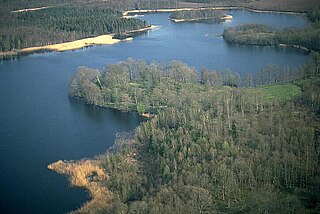 W
WAxevalla House is the ruins of a medieval castle in the parish of Skärv in the municipality of Skara, Västergötland, Sweden. It is located on a headland by Lake Husesjön, east of the heathland of Axevalla Hed and halfway between the cities Skara and Skövde.
 W
WBoden Fortress is a modern fortress consisting of several major and minor forts and fortifications surrounding the city of Boden, Norrbotten, in northern Sweden. The fortress was originally intended to stop or delay attacks from the east or coastal assaults, which at the time of construction meant Russian attacks launched from Finland. It was primarily the expansion of the railway net in Norrland, which in turn was a consequence of the rising importance of the northern iron ore fields, that led to the increased strategic value of northern Sweden and the construction of the fortress. Although the main forts were finished in 1908, many of the supporting fortifications were not completed until the start of the First World War. Improvements were also continuously made during, and between, both World Wars.
 W
WBohus Fortress lies along the old Norwegian–Swedish border in Kungälv, Bohuslän, Sweden, north east from Hisingen where the Göta river splits into two branches. It commands the surrounding area from a cliff 40 m (130 ft) high, with the river forming a natural moat around it.
 W
WThe Bulverket is the remnants of a large wooden fortification or bulwark at Lake Tingstäde on the island of Gotland, Sweden. When built, it consisted of a platform with houses surrounded by a double palisade with the entire construction around 250 m (820 ft) in diameter.
 W
WCarlsten is a stone fortress located at Marstrand, on the western coast of Sweden. The fortress was built on the orders of King Carl X of Sweden following the Treaty of Roskilde, 1658 to protect the newly acquired province of Bohuslän from hostile attacks. The site of Marstrand was chosen because of its location and its access to an ice free port. The fortress was decommissioned as a permanent defense installation in 1882, but remained in military use until the early 1990s.
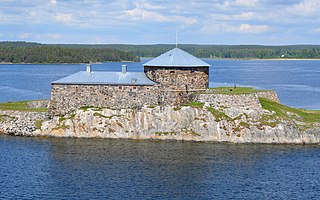 W
WDalarö fortress is a fortification located just south of Dalarö. The current structure was built by Charles X Gustav of Sweden in 1656.
 W
WFalkenberg (Falkenbergshus) was a fort located at Falkenberg in Halland County, Sweden. The fortfication was located on the south strand of the river Ätran, about 60 m (200 ft) from the southern abutment of Falkenberg Bridge. It would later give name to the town of Falkenberg which was previously known as Ätraby.
 W
WFårösund Fortress is a decommissioned fortification in Fårösund on Gotland, Sweden, which was built from 1885 to 1886.
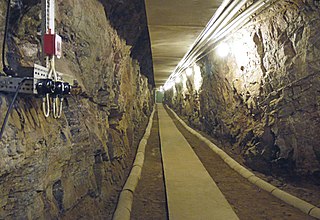 W
WFemöre battery (Femörefortet) is a facility previously operated by the Swedish Coastal Artillery arm of Swedish Armed Forces. Also known as "Battery OD", it is located only a short trip south-east of Oxelösund on the Swedish east coast, and is blasted into the rock on the Femöre peninsula. The facility totals approx. 3,300 square metres (36,000 sq ft) in size, and is connected via an over 450 metres (1,480 ft) long tunnel, stretching across the length of the facility.
 W
WFortifications of Gothenburg were initially embankments along the newly dug city moat (Vallgraven) in Gothenburg, Sweden. They were built to defend Gothenburg which was Sweden's only direct access to the North Sea and Atlantic Ocean.
 W
WJärflotta is an island in Stockholm archipelago, approximately 5 km (3.1 mi) south of Nynäshamn. Once separated from the mainland by a natural sound, this navigable route was rendered unusable in more modern times by post-glacial rebound and has been replaced by the artificial Draget Canal. The island is a nature reserve.
 W
WKarlsborg Fortress is situated on the Vanäs peninsula in Karlsborg by lake Vättern, the province of Västergötland, Sweden. Construction on the fortress began 1819 to realize the so-called central defense idea adopted by the Swedish military after the Finnish and Napoleonic Wars. The site was chosen by Baltzar von Platen in connection with the construction of Göta Canal.
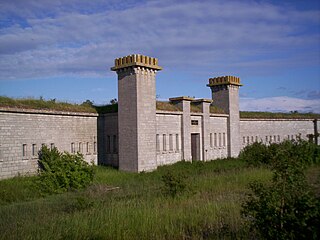 W
WKarlsvärd Fortress is a former fortification on the island of Enholmen near Slite on Gotland, Sweden. In its place Enholmen Fortress was built in the mid-1800s. It was decommissioned in 1905 and was then used as a training ground for the coastal artillery. During the 1990s it was used as a naval mine control station before the island was demilitarized in 2011. Karlsvärd Fortress ruin is since 2015 managed by the National Property Board.
 W
WKastelholm Castle is a Swedish-built medieval castle located off Road 2 in Sund, Åland, Finland, approximately 25 kilometres (16 mi) northeast of Mariehamn, overlooking a fjord to the south of the village of Kastelholm. Along with Hämeenlinna, Olavinlinna in Savonlinna, Raasepori, and Turku, Kastelholm is one of only five surviving Finnish medieval fortresses that are also considered to be architecturally substantial. Built in the 14th century, and held in fief during the Middle Ages by various nobles, feudal chiefs, and kings, it had significant period in the 15th and 16th centuries.
 W
WKastellet is a small citadel located on the islet Kastellholmen in central Stockholm, Sweden.
 W
WKorela Fortress, at the town of Priozersk, Leningrad Oblast, Russia.
 W
WKyrö Skantz, or Kyrön skanssi (Finnish) or Kyrö skans (Swedish), was a fortress built for the Swedish army in the 17th century. The ruins of Kyrö Skantz are located in Karvia, Finland. It's obvious that there was a small military base at the same area in the late 16th century but there is only very little information available about it.
 W
WNyenschantz was a Swedish fortress at the confluence of the Neva River and Okhta River, the site of present-day Saint Petersburg, Russia. Nyenschantz was built in 1611 to establish Swedish rule in Ingria, which had been annexed from the Tsardom of Russia during the Time of Troubles. The town of Nyen, which formed around Nyenschantz, became a wealthy trading center and a capital of Swedish Ingria during the 17th century. In 1702, Nyenschantz and Nyen were conquered by Russia during the Great Northern War, and the new Russian capital of Saint Petersburg was established by Peter the Great in their place the following year.
 W
WShlisselburg is a town in Kirovsky District of Leningrad Oblast, Russia, located at the head of the Neva River on Lake Ladoga, 35 kilometers (22 mi) east of St. Petersburg. From 1944 to 1992, it was known as Petrokrepost (Петрокрепость). Population: 13,170 (2010 Census); 12,401 (2002 Census); 12,589 (1989 Census).
 W
WThe Skåne Line, popularly known as the Per Albin Line after then-Prime Minister Per Albin Hansson, was a 500 kilometer long line of light fortifications erected during World War II around the coast of southern Sweden to protect the country from a possible German or Soviet invasion. It stretched from Halland across Skåne to Blekinge and consisted of two defensive lines:First defensive line: concrete bunkers along the shore, armed with machine guns and light cannons. Second defensive line: armed troops 300 meters inland behind barbed wire, some in concrete bunkers.
 W
WSkansen Kronan is a redoubt in the district of Haga of Gothenburg, Sweden.
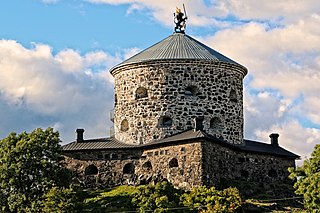 W
WSkansen Lejonet ("the Lion sconce") is a redoubt in Gothenburg, Sweden, built in 1687. Since 1822 it has served other purposes.
 W
WSuomenlinna, or Sveaborg (Swedish), is an inhabited sea fortress built on eight islands about 4 km southeast of the city center of Helsinki, the capital of Finland. Suomenlinna is a UNESCO World Heritage site that is popular with tourists and locals, who enjoy it as a picturesque picnic site. Originally named Sveaborg, or Viapori as referred to by Finnish-speaking Finns, it was renamed in Finnish to Suomenlinna in 1918 for patriotic and nationalistic reasons, though it is still known by its original name in Sweden and by Swedish-speaking Finns.
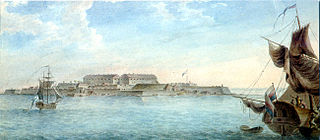 W
WThe Svartholm fortress was built between 1749 and 1764 outside Loviisa in Southern Finland by Augustin Ehrensvärd. The fortress, which lies at the mouth of the Bay of Loviisa, along with the planned land fortress at Loviisa, would have prevented invading Russian forces from entering what was then Swedish territory in present-day Finland.
 W
WSuomenlinna, or Sveaborg (Swedish), is an inhabited sea fortress built on eight islands about 4 km southeast of the city center of Helsinki, the capital of Finland. Suomenlinna is a UNESCO World Heritage site that is popular with tourists and locals, who enjoy it as a picturesque picnic site. Originally named Sveaborg, or Viapori as referred to by Finnish-speaking Finns, it was renamed in Finnish to Suomenlinna in 1918 for patriotic and nationalistic reasons, though it is still known by its original name in Sweden and by Swedish-speaking Finns.
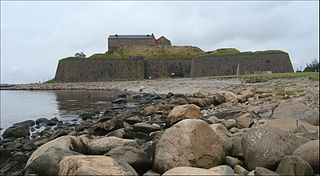 W
WVarberg Fortress is a former fortification in Varberg, Halland County, Sweden, which currently serves as a museum.
 W
WVaxholm Fortress is a historic fortification on the island of Vaxholmen in the Stockholm archipelago just east of the Swedish town of Vaxholm. The fortress is accessed by the Kastellet ferry, an electrically powered cable ferry across the channel from Vaxholm town.
 W
WVisborg (Wisborg) refers to a fortress in the town of Visby on the Swedish island of Gotland. Successive fortresses were built in Visby, though Visborg is usually in reference to the castle built here by King Eric of Denmark, Norway and Sweden.
 W
WVyborg Castle is a Swedish-built medieval fortress around which the town of Vyborg evolved. The castle became the stronghold of the Swedish realm in the Karelian region. Throughout the centuries, it was the first defence of the kingdom against Russians. Its military and strategic status in the late Middle Ages was second only to the fortified capital Stockholm. Currently it serves as the site of Vyborg Regional Museum.